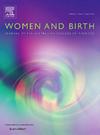孟加拉国农村孕妇的睡眠习惯和仰卧睡姿与死产之间的关系
IF 4.1
2区 医学
Q1 NURSING
引用次数: 0
摘要
目的了解产妇的睡眠习惯,探讨产妇仰卧睡姿与死产的关系。方法本研究是对在孟加拉国Sherpur地区进行的以社区为基础的集群随机对照试验的对照组进行的二次分析。在2021年5月至2021年11月期间,对参与者前瞻性地进行了母亲睡眠姿势问卷调查。在参与者出生后10天内,由现场工作人员收集妊娠结局。采用多元泊松回归模型评估死产与仰卧睡姿之间的关系,报告相对危险度(RR)和调整相对危险度(aRR),置信区间为95% %。结果我们纳入了799名分娩的参与和符合条件的对照妇女。95.1% %的女性报告侧卧睡姿,4.8% %的女性报告仰卧睡姿。有19例死产,每1000例分娩24例。与他人同床共枕、睡眠的舒适程度与睡眠姿势无关。仰卧睡姿与死产无关联(aRR 2.07, 95 % CI 0.59-7.28)。结论:本研究未发现仰卧睡姿与死产之间的关联,这可能是由于研究结果中死产的发生率较低,以及仰卧睡姿的发生率较低。这是在低收入和中等收入国家对怀孕期间的睡眠习惯和睡眠环境进行评估的最大规模的研究。本文章由计算机程序翻译,如有差异,请以英文原文为准。
Sleep practices and association between supine sleep position and stillbirth in a rural sample of pregnant women in Bangladesh
Objective
To describe maternal sleep practices and assess the association between maternal supine sleep position and stillbirth.
Methods
The study was a secondary analysis of the control arm of a community-based cluster randomised controlled trial conducted in the Sherpur district of Bangladesh. A maternal sleep position questionnaire was prospectively administered to participants between May 2021 and November 2021. Pregnancy outcomes were collected by the field staff within 10 days of birth for participants. Multivariate Poisson regression model was used to evaluate the association between stillbirth and supine falling-to-sleep position, reporting both the relative risk (RR), adjusted relative risk (aRR) with 95 % confidence intervals.
Results
We included 799 births of the participating and eligible control women. A lateral sleep position was reported by 95.1 % of women, 4.8 % reported a supine sleep position. There were 19 stillbirths, a rate of 24 per 1000 births. Sharing the bed with others, ease of sleeping and level of comfort were not found to be associated with sleep position. There was no association between supine falling-to-sleep position and stillbirth (aRR 2.07, 95 % CI 0.59–7.28).
Conclusion
The study did not identify an association between supine sleep position and stillbirth, which may be due to both the low prevalence of stillbirth as an outcome of research, and the low frequency of supine sleep position. This is the largest study within a low-and-middle income country to assess sleep practices and sleep environment in pregnancy.
求助全文
通过发布文献求助,成功后即可免费获取论文全文。
去求助
来源期刊

Women and Birth
NURSING-OBSTETRICS & GYNECOLOGY
CiteScore
7.20
自引率
13.20%
发文量
371
审稿时长
27 days
期刊介绍:
Women and Birth is the official journal of the Australian College of Midwives (ACM). It is a midwifery journal that publishes on all matters that affect women and birth, from pre-conceptual counselling, through pregnancy, birth, and the first six weeks postnatal. All papers accepted will draw from and contribute to the relevant contemporary research, policy and/or theoretical literature. We seek research papers, quality assurances papers (with ethical approval) discussion papers, clinical practice papers, case studies and original literature reviews.
Our women-centred focus is inclusive of the family, fetus and newborn, both well and sick, and covers both healthy and complex pregnancies and births. The journal seeks papers that take a woman-centred focus on maternity services, epidemiology, primary health care, reproductive psycho/physiology, midwifery practice, theory, research, education, management and leadership. We also seek relevant papers on maternal mental health and neonatal well-being, natural and complementary therapies, local, national and international policy, management, politics, economics and societal and cultural issues as they affect childbearing women and their families. Topics may include, where appropriate, neonatal care, child and family health, women’s health, related to pregnancy, birth and the postpartum, including lactation. Interprofessional papers relevant to midwifery are welcome. Articles are double blind peer-reviewed, primarily by experts in the field of the submitted work.
 求助内容:
求助内容: 应助结果提醒方式:
应助结果提醒方式:


